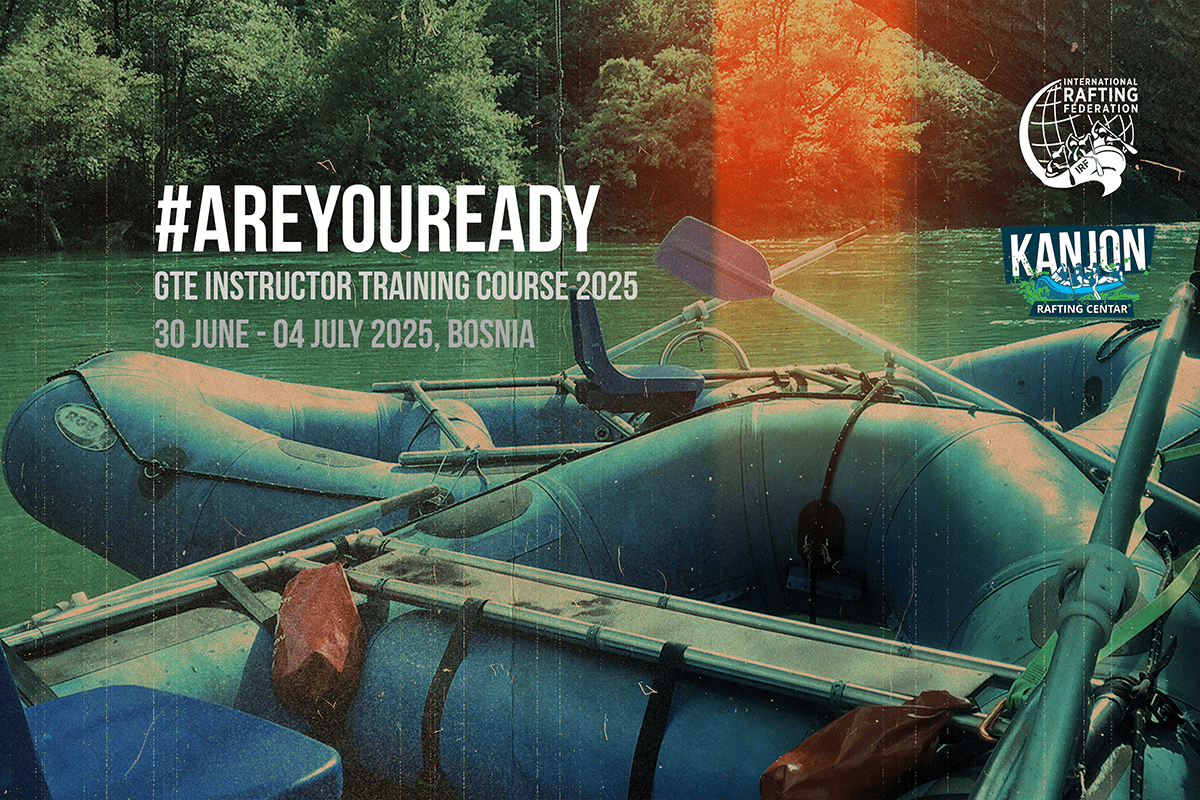Mark Hirst, an IRF GT&E Instructor, has written a great article about how to deliver good Safety Talks at a start of a river trip – here is what he has to say:
Over the years I have had the opportunity to witness some professional, motivating raft safety talks and unfortunately some painfully poor safety talks. I wanted to share some of my thoughts behind a safety brief. This post will hopefully share some of my ideas and hopefully start a productive discussion.
I want to divide the topic into a few separate areas.
- The setting & introduction
- The delivery & content order
- The unspoken messages finding the humour balance
- The wrap up & mantra
- The language& communication thing
1. The setting and introduction
Let’s imagine you are going onto stage to perform. In order to perform at your best you need everything around you to fall into place and work in harmony to make an effective performance (after all that’s what a safety talk is). So – let’s look at a few things to help get the setting right.
Mental setting
You should clear your mind of any distractions for the next 20 minutes. No phones, no outside distractions. Your only focus is making sure your customers receive the best possible safety talk to enable them to have the best possible trip.
I constantly use this mantra as a trip leader: “Poor safety talk poor trip” or “outstanding safety talk outstanding trip”.
Appearance
Would you be taken seriously at that job interview if you were not dressed properly or using the correct body language? Here are few hard fast rules I use:
- No sunglasses if possible, eye contact is everything
- Fully kitted and ready for action
- Look, talk, and think professional and the rest will follow
Setting (environment)
You need to make yourself the sole focus of the customers for the duration of your safety talk. Take away any distractions. Once your customers are distracted it’s really hard to get them back. Below are a few top tips.
- Move them if possible to a quiet secluded place. If this is not possible have them sit or stand with their back to the river.
“A common mistake I see during a safety talk is with the customers looking out onto the river. This makes it really hard to keep their attention especially if there are other companies or a big rapid at the put in point. Your customers will look at the impending doom and never focus on you or your safety talk.” - Take away any reasons to fidget. Make sure all helmets & PFDs are already fully adjusted. All cameras, Go-Pros are to be left alone and banned for the duration of the safety talk.
- If possible have the customers with the sun & wind behind them. Buses can be used as wind breaks.
- If your customers are standing get the small people to the front along with any customers who might not speak the same language as you so that they can get a clear view of the talk. Do not have any customers behind you or out of your field of vision.
“As a guide it is important to be able to make eye contact with all of your customers during the safety talk. Making eye contact with your customers will make then focus on you more. You will also be able to read your customers’ feelings by looking at their faces. From this you will be able to work out the confident from the nervous customers.”
Introduction
Now that you have the attention of your customers, you start by telling them the most obvious things; your name and the names of your guide team and what you are going to do and why you are doing it
“Now we are going to spend 15 – 20 minutes talking about the trip and the trip safety. It’s important you listen to me as you will then know how to paddle and what to do if you fall out of the raft”.
Summary:
- Clear you own head and prepare yourself first
- Make sure your customers are in a position where you are their sole focus
- Eye contact is everything
- Tell them what you are doing and why you are doing it
Now the setting is correct it’s time to give them some technical information.
2. The delivery & content order
The delivery style of your talk is highly important. On days when the river is high and you know it’s going to be a seat of the pants trip your delivery style will have a higher sense of urgency compared to the days when you are working during lower water levels.
Remember being a good guide is mainly about people skills; be yourself. Don’t become some type of transfixed military robot reading a script without an understanding of what you are talking about. Inject some emotion into your safety talk.
Relax, talk with a smile and be human, eye contact is everything. Raise your voice when you need to in order to highlight the important points.
You can always try some role reversal: imagine yourself as a customer going on a scary raft trip. How would you like to be spoken to?
Content order: I have had many heated discussion with fellow guides on the content order of a safety talk. I have taken on board their views and here is what we came up with:
- Don’t adjust or take off any of the safety kit we give without our permission.
- The paddle and T pieces
- The raft and your seating position
- Efficient forwards & backwards paddling techniques
- What to do if you fall out. The OBE, outer boat experience. (smile, hold your paddle, swim back)
- The outside line & getting someone back in
- Reaching rescue with paddles
- Aggressive proactive swimming
- White water swimming position (look around, be active in your own rescue, don’t just sit there)
- Throw bags
- Flips (physically flip the raft on the land and do a dry land flip drill)
- Safety kayakers /safety rafts
 Paddle Drill: The one thing I will be asking my crew to do more than anything is to paddle – so it is worth a little extra time working with the crew on their paddling technique and timing.
Paddle Drill: The one thing I will be asking my crew to do more than anything is to paddle – so it is worth a little extra time working with the crew on their paddling technique and timing.
“I used to work for a company that would deliver a really comprehensive safety talk, but no time would be given on showing the customers how to paddle. Yes, all of our customers were well briefed on what to do if the raft flipped but none of them could paddle.”
So – get your customers to paddle well to avoid getting into situations where they will be swimming.
Read about 3.The unspoken messages finding the humour balance, 4. The wrap up & mantra and 5. The language & communication thing in Part 2: Safety Talks – getting it right – Part 2.
Mark is an IRF Guide Training & Education Instructor who runs courses and and workshops in a wide variety of countries from Iceland to India and Nepal. He hails initially from Great Britain. If you’d like Mark to run a workshop for you contact him via his webpage.









